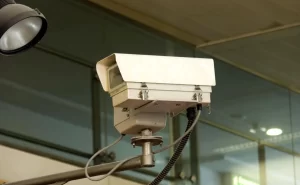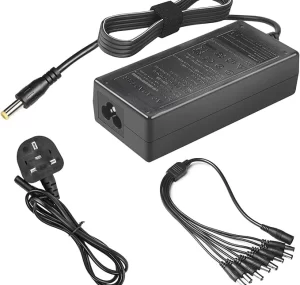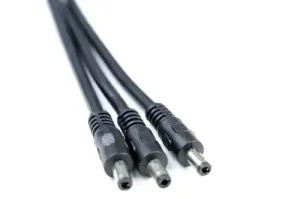How to Select the Right DC Power Cable and Power Supply for CCTV Cameras
The reliability of a CCTV system is largely decided by its electricity supply and DC power cables. Inappropriate configurations can result in equipment faults, system downtime reduction, and expensive repairs. This comprehensive blog dives into the 3 main power supply modes, their benefits and shortcomings, how to pick out the correct DC power cables, and extra considerations for crafting a robust and scalable surveillance system.
Independent Power Supply Mode for CCTV Cameras
An independent power supply mode allocates a dedicated power source for each camera. It serves as a practical option for small systems or where high reliability for single cameras is a key.
-
- Profits of Independent Power Supply
- Troubleshooting Simplification
When a camera malfunctions, the problem can be easily isolated. With each camera powered individually, the failed unit can be replaced with no disruption to the rest of the system. - System Downtime Minimization
A fault in one electricity source impacts only its related camera. This isolation avoids a complete system outage and makes sure critical areas remain controlled. - Improved Security for Critical Zones
Cameras monitoring high-priority regions, such as entrances, exits, or cash registers, can be individually powered to maximize reliability.- Drawbacks of Independent Power Supply
- Higher Investment
Individual setups are more costly because of the demand for several power supplies. Extra expenses involve investing in separate DC power cables for each camera. - Increased Risk of Environmental Damage
Cameras for outdoor uses powered individually are vulnerable to environmental conditions such as rain, high-heat, or lightning. Special weather-resistant power supplies and enclosures are needed, which further increases costs.
Practical Instance:
A small retail store with 4 cameras gets profits from the independent mode since reliability is ensured for critical areas, such as the cash register or entrance, even if one power supply malfunctions.
Centralized Power Supply Mode for CCTV Cameras
In the centralized power supply mode, one electricity source delivers electricity to several cameras. It’s commonly applied in medium and large setups because it is cost-saving and the repairs are simplified.
Role of Centralized Power Supply
Centralized systems serve as the backbone of larger CCTV setups, which allows for efficient power delivery and streamlined management. They are usually integrated with IT infrastructure to enable real-time failure monitoring and proactive maintenance.
-
- Profits of Centralized Power Supply
- Cost Efficiency
Centralized systems are more affordable for large electrical setups. Multiple independent units can be replaced by an individual, high-capacity power supply. - Ease of Maintenance
With all power elements housed in one location, it is straightforward to diagnose and solve issues. - Energy Efficiency
Centralized setups optimize energy usage by decreasing unnecessary power sources.- Drawbacks of Centralized Power Supply
- Complication in Planning
Precise calculations are needed by centralized systems to account for startup currents and transfer losses. An engineer must factor in a 30% safety margin for scalability and uncertain cases. - Risk of System Paralysis
A single failure in the power supply causes disability for all linked cameras unless a backup like a UPS is available.
Calculation Instance for Mid-Sized Setups:
For a system with 16 cameras, each requiring 5W, the power calculation follows:
16×5=80W×1.3(startup margin)×1.3(transmission losses)=135.2W.16 \times 5 = 80W \times 1.3 (\text{startup margin}) \times 1.3 (\text{transmission losses}) = 135.2W.16×5=80W×1.3(startup margin)×1.3(transmission losses)=135.2W.
Add a 30 percent margin for scalability:
135.2×1.3=175.76W.135.2 \times 1.3 = 175.76W.135.2×1.3=175.76W.
A centralized power supply with a capacity of at least 180W would be advisable.
Power over Ethernet Power Supply Mode
PoE technology integrates electricity and data transfer into an individual Ethernet cable, which simplifies the setup process and decreases cabling costs. And, it is increasingly welcomed in modern, data-driven surveillance systems.
-
- PoE Configuration
- Switch & Terminal Both Support PoE
By using Ethernet cables, this configuration directly powers PoE-compatible cameras, with no extra hardware required. - PoE Switch, Non-PoE Terminal
Power and data are separated by a PoE splitter, enabling it to be possible to link non-PoE cameras. - Non-PoE Switch, PoE Terminal
A PoE injector distributes power into the Ethernet cable, allowing for compatibility with PoE cameras. - Neither Switch nor Terminal Supports PoE
The combination of injectors and splitters allows for PoE functionality in traditional setups.- Profits of PoE
- Streamlined Cabling
The demand for separate power lines is eliminated by PoE, which reduces setup costs and complexity. - Enhanced Scalability
New cameras can be added easily with no extra power outlets needed. - Improved Flexibility
PoE systems are working perfectly for remote locations or outdoor setups with no easy access to power sources.
Selection Between Independent & Centralized Power Supply
The option between independent and centralized power supply is decided by the scale of the setup, the distance between cameras, and the criticality of controlled zones.
Small Systems (4 Cameras or Fewer):
A small system includes an independent power supply mode where reliability and simplicity can be ensured.
Mid-Sized Systems (4 to 16 Cameras):
Centralized systems bring more reduction to cost and easier management.
Large Systems (16 Cameras or More):
A hybrid approach that combines centralized and PoE systems ensures flexibility, scalability, and reliability.
Avoid Common Pitfalls in Power Configuration
- A single power source can be used for all cameras, which increases the risk of complete system paralysis in case the power supply fails.
- Also, startup currents may be underestimated. In typical cases, a higher current is needed for cameras during installations, which must be considered when calculating the power supply.
Practical Case:
The distribution of power across several sources. For instance, a system with 100 cameras requiring 878W can be categorized into 4 220W power supplies, which reduces the effect of single-point faults.
Picking Out the Correct DC Power Cable
The DC power cable serves as an essential element of your CCTV system, allowing for steady power delivery to cameras. Some main considerations are:
Cable Length & Voltage Drop
Longer cables introduce resistance, resulting in voltage drops. For distances over 100m, thicker cables or higher voltage power supplies should be selected.
-
- The Kinds of Cable
- Standard DC Power Cables that are appropriate for short-distance setups.
- DC Power Extension Cables that extend existing power lines for extra flexibility.
- PoE Ethernet Cables that combine power and data transfer for PoE setups.
Importance of Quality
Premium cables guarantee consistent performance and durability. Poor-quality cables may lead to power fluctuations, resulting in inefficient operation or other damages.
Sustainability & Future-proofing in CCTV Systems
As environmental concerns increase, sustainable practices adopted in CCTV setups are essential.
- Energy-Saving Elements
Power supplies and components that are crafted to minimize energy consumption should be used. - Eco-Friendly Material
Always opt for halogen-free and recyclable cables. - Smart Monitoring Systems
Tools should be implemented to monitor power usage and optimize energy savings.
Advanced Techniques for Expanding CCTV Systems
- Modular Power Supply
It enables seamless extension when new cameras are added, decreasing the demand for entire overhauls. - Battery Backup Systems
UPS solutions guarantee constant power during outages, which enhances system reliability. - Hybrid Configuration
Centralized and PoE systems can be combined to maximize flexibility and adaptability.
The choice of power supply and DC power cable works as the backbone of the performance and reliability of a CCTV system. By learning about the differences between independent, centralized, and PoE power supply modes, your system can be tailored to fit specific demands while reducing cost, enhancing scalability, and ensuring long-term efficiency.
If you keep an eye on premium DC power cables and professional tips, we Vocson, your trusted suppliers, supply premium products for you to build a surveillance system prepared to tackle today’s challenges and adapt to future needs.
Related Reading
Things You Should Know Before Buying Lightbar Wiring Harnesses




